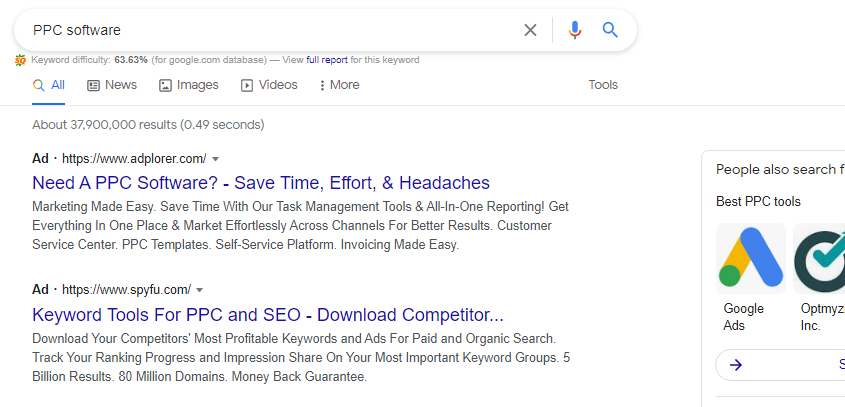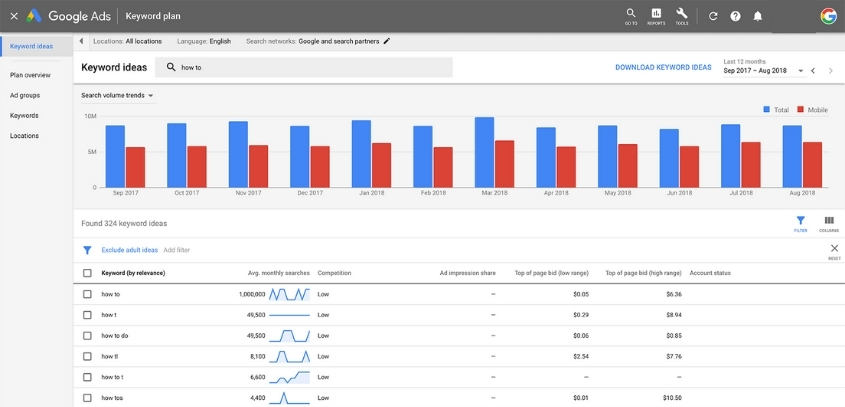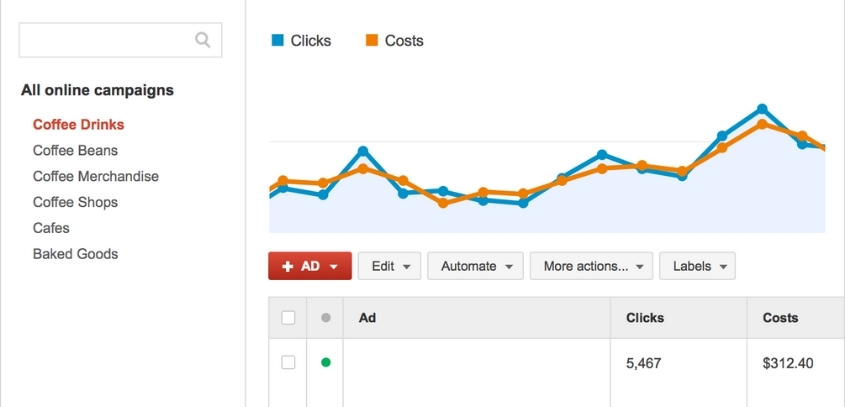Did you know that a pay-per-click (PPC) ad is clicked on 65 percent of all high-intent searches?
PPC advertising are an excellent strategy to increase traffic and generate leads for your company.
You’ll gain a better knowledge of your campaign and be able to adjust your PPC to get better results by completing a PPC analysis.
Pay-per-click (PPC) ads are an excellent technique for any business to increase traffic and create leads.
You may get a better sense of your ad campaign by conducting an in-depth PPC study. You may then utilize that information to improve your PPC advertisements and get better results.
What is Pay-per-click?
Pay-per-click (PPC) is an internet marketing approach in which advertisers are charged a fee each time one of their adverts is clicked.
Essentially, it’s a technique of purchasing website traffic rather than trying to “earn” it organically.
One of the most common types of PPC is search engine advertising. When someone searches for a keyword relating to their company offering, it allows advertisers to bid for ad placement in a search engine’s sponsored links.
If we bid on the keyword “PPC software,” for example, our ad might appear at the very top of the Google results page.

We must pay a tiny fee to the search engine every time our ad is clicked, resulting in a visitor to our website.
When PPC is working properly, the charge is insignificant because the visit is worth more than the amount you pay.
In other words, if we pay $3 for a click that results in a $300 transaction, we’ve profited handsomely.
There’s a lot that goes into creating a successful PPC campaign, from researching and picking the correct keywords to structuring those keywords into well-organized campaigns and ad groups to creating conversion-optimized PPC landing pages.
Advertisers who can construct relevant, intelligently focused pay-per-click campaigns are rewarded by search engines, who charge them less for ad clicks.
Google costs you less per click if your advertising and landing pages are useful and gratifying to users, resulting in better profits for your company. If you want to start utilizing PPC, you must first learn how to do it correctly.
What are Google Ads?
Google Ads is the most widely used pay-per-click (PPC) advertising system on the planet.
Businesses can use the Ads platform to produce advertisements that display on Google’s search engine and other Google domains.

Users bid on keywords and pay for each click on their ads in Google Ads, which works on a pay-per-click premise.
When a user conducts a search, Google looks through its pool of Ads advertisers and selects a few winners to appear in the premium ad space on the search results page.
The “winners” are determined by a number of factors, including the quality and relevancy of their keywords and ad campaigns, as well as the size of their keyword bids.
Ad Rank is a statistic generated by multiplying two important elements – CPC Bid (the maximum amount an advertiser is willing to spend) and Quality Score – to determine who gets to appear on the page (a value that takes into account your click-through rate, relevance, and landing page quality).
This technique enables winning advertisers to reach out to potential customers at a price that is affordable to them. It’s essentially a bidding war.
PPC marketing with Google Advertising is especially beneficial since, being the most prominent search engine, Google receives a lot of traffic and so delivers the most impressions and clicks to your ads.
The frequency with which your PPC ads appear is determined by the keywords and match types you choose. While many aspects influence the performance of your PPC advertising campaign, you can achieve a lot by concentrating on:
Relevance of keywords – Creating relevant PPC keyword lists, keyword groups, and ad copy.
Landing Page Quality — Creating optimized landing pages that are suited to individual search queries and include convincing, relevant content and a clear call-to-action.
Quality Score — Google assigns a score to your keywords, landing pages, and PPC ads based on their quality and relevancy. Advertisers with higher Quality Scores receive more ad clicks for less money.
Creative: Creative ad wording is essential, and if you’re advertising on the display network, you can use a tool like free Smart Ads Creator to produce designer-quality ads that will entice people to click.
How to Do Effective PPC Keyword Research?
Keyword research for PPC might be time-consuming, but it is critical.
Keywords are the foundation of your entire PPC campaign, and the most successful Google Ads marketers are always expanding and refining their keyword list.

If you simply undertake keyword research once, while creating your initial campaign, you’re likely missing out on hundreds of thousands of useful, long-tail, low-cost, and highly relevant phrases that might drive traffic to your site.
The following is an example of a good PPC keyword list:
Relevant – Obviously, you don’t want to pay for website traffic that has nothing to do with your company.
You want to select keywords that will boost your PPC click-through rate, cost per click effectiveness, and profitability.
That is to say, the keywords you bid on should be directly relevant to the products and services you offer.
Extensive – Your keyword research should not only contain the most popular and often searched terms in your niche, but also the long tail of search terms.
Long-tail keywords are less prevalent and more precise, but they account for the majority of search traffic. They’re also less expensive because they’re less competitive.
Expansive: PPC is iterative and expansive. You want to keep refining and expanding your campaigns, as well as creating an atmosphere where your keyword list grows and adapts.
Managing Your PPC Campaigns:
After you’ve created your new campaigns, you’ll need to monitor them on a regular basis to ensure that they remain effective.

In fact, one of the biggest predictors of account success is consistent account activity. You should be reviewing your account’s performance on a regular basis and making the following changes to optimize your campaigns:
PPC Keywords: Increase the reach of your PPC advertisements by include keywords that are relevant to your company.
Add Negative Keywords: To boost campaign relevancy and prevent wasted spend, add non-converting terms as negative keywords.
Split Ad Groups: Splitting your ad groups into smaller, more relevant ad groups can help you produce more focused ad copy and landing pages, which will improve your click-through rate (CTR) and Quality Score.
Examine Expensive PPC Keywords: Examine your most expensive and underperforming keywords and, if required, turn them off.
Landing Pages Should Be Improved: To increase conversions, connect the content and calls-to-action (CTAs) of your landing pages with specific search queries.
5 Key Metrics for PPC Analysis
It’s critical that you know what to look for as you prepare to set up and execute your PPC analysis. Let’s look at five metrics that should be included in your analysis.
1. Wasted Spend
When conducting a PPC analysis, the last thing you want to do is squander money. When assessing your PPC campaign, search for areas where you could be squandering money.
Look at your wasted spend ad metric when you’re analyzing your campaign. This will reveal where you’re squandering money.
For example, if the advertisements you’re running aren’t getting much attention, you can see how much money you’re wasting on them in your analysis.
This is an important indicator to track since it allows you to improve certain aspects of your account in order to spend your money more intelligently. To boost the performance of your campaign, you can adjust your keyword selection or optimize the time of day your ad runs.
2. Quality Score
One of the most significant criteria for your PPC campaign is your quality score. If you’ve ever looked up how PPC works, you’re aware that quality score is a key aspect of the process.
Google assigns a quality score to your ad in order to determine its ranking. Google seeks to give the most relevant information for its users’ search queries. If you want to receive good ad placement, you must produce an ad that is relevant to your audience.
Relevance, ad copy, and keyword selection are all elements that Google considers when determining your quality score.
So, how do you raise your quality rating?
The greatest strategy to increase your quality score when it comes to this measure is to write relevant ad material. After you’ve chosen your keywords, double-check that your ad copy is appropriate to them.
When conducting a PPC strategy analysis, keep an eye on your quality score and aim to enhance it in order to boost your ranking.
3. Impressions Share
Your impression share is another useful metric to keep track of. The percentage of times your adverts are triggered by relevant search queries is known as impression share. This is an important measure to track since it indicates how frequently your target audience types in a relevant question that causes your ad to appear in the search results.
Your ad isn’t showing up in many relevant search results if you have a poor impression share. People aren’t looking for terms associated with your ad; thus, they aren’t seeing it. It will have a negative effect on your PPC campaign.
Continue to monitor your impression share to determine if your ad is consistently triggered in your PPC campaign to ensure success.
4. Click Through Rate (CTR)
Another important indicator to keep track of in your PPC analysis is the clickthrough rate (CTR). This is one of the most crucial PPC metrics. Your CTR indicates how often people engage with your ad by clicking on it.
You want them to engage with the material on your landing page by clicking on your ad. If searchers aren’t actively clicking on your ad, having a high impression share isn’t enough. If no one clicks on your ad, you won’t get a good return on your investment (ROI).
Monitoring your CTR allows you to see if you’re still competing with your rivals. You can see how many clicks you’re getting to evaluate if your advertising is still engaging.
It’s also a wonderful approach to compare your ROI to ad clicks to evaluate if your ad language is relevant and effective at driving conversions.
5. Ad Text Optimization
The wording in your ad is an important aspect of any campaign. It can decide whether your audience is interested in your ad and engages with it, or if they return to the search results to discover a different business.
When conducting your PPC analysis, keep an eye on your ad wording. Check out how your ad text is affecting your CTR, quality score, and ROI right now. The performance grader for Google Ads will assess your ad’s effectiveness and provide you with a benchmark comparison of how your ad text compares to that of your competitors.
You will gain a better understanding of your campaign’s success and be able to change it to drive better results by monitoring your text to see how it produces results for your campaign.
4 pointers on How to do an Effective PPC analysis
Now that you know which indicators to keep an eye on, you can begin your PPC analysis. Let’s look at five suggestions for conducting a successful PPC analysis.
Now that you know which indicators to keep an eye on, you can begin your PPC analysis. Let’s look at five suggestions for conducting a successful PPC analysis.
1. Examine your account setup.
Reviewing your account structure is the first step in doing a successful PPC analysis. You may improve your campaign by expanding, testing, and analyzing your site.
So, when it comes to examining your account structure, what should you look for?
- The amount of campaigns you’ve run
- Your ad groups and the way they’re divided
- Your method of bidding
- Your campaign’s preferences
- Your financial situation
All of these factors have an impact on the success of your campaign. Examine each of these elements to make sure they’re functioning for your campaign.
2. Examine your target audience.
The next stage in conducting a successful PPC audit is to examine your target audience. Your target audience is an important part of your PPC amalysis. To guarantee that you’re building a campaign that works for them, you need to learn more about them.
To begin, determine which devices your target audience is utilizing to reach your PPC ad. Do they prefer to view your PPC advertisements on their phones, tablets, or computers? Knowing this information allows you to develop a stronger bid strategy and concentrate on tailoring your advertising to the device that your target audience uses the most.
Next, take a look at who is interacting with your target audience. To better understand your audience, look at demographic data, socioeconomic status, and interests. You might discover that your target audience is different or larger than you anticipated.
When you have a better understanding of your target demographic, you can write better ad text for them. This will result in more engagement and conversions for your company.
3. Take a look at when you’re going to post your adverts.
Examine when you submit your ads to execute a good PPC audit. If you have a restricted budget and want to make the most of it, this is a great strategy to use.
When you examine your posting times, you can observe when your ads are most effective and when they receive the least amount of traffic. You can improve your campaign to avoid wasting ad spend by evaluating your traffic and the times they engage with your ad. When your audience isn’t responding to your adverts, you can turn them off.
You can run a more efficient PPC campaign for your business by evaluating the times you run your advertising.
4. Examine your competitors.
When conducting a PPC analysis, it’s crucial to look at your competition as well. You must be aware of your competitors and how their campaigns are performing in comparison to yours.
The keywords used by your competitors are an important factor to consider. Because keywords are such an important element of your strategy, it’s crucial to look at what your competitors are using.
You can identify fresh keywords for your campaign by analyzing your competitors’ keywords. You’ll get keyword suggestions that will help you rank for more keywords. This is a fantastic strategy to stay competitive.
You’ll gain a better understanding of who is attempting to rank for the same keywords as you by evaluating your competitors. You’ll also learn about fresh keywords you might use in your campaign.
Omer Nadeem
Co-Founder of artimization who is passionate about bringing colour, clarity and budget-ability to businesses' experience of IT.
 Make Custom Package
Make Custom Package




No Comments